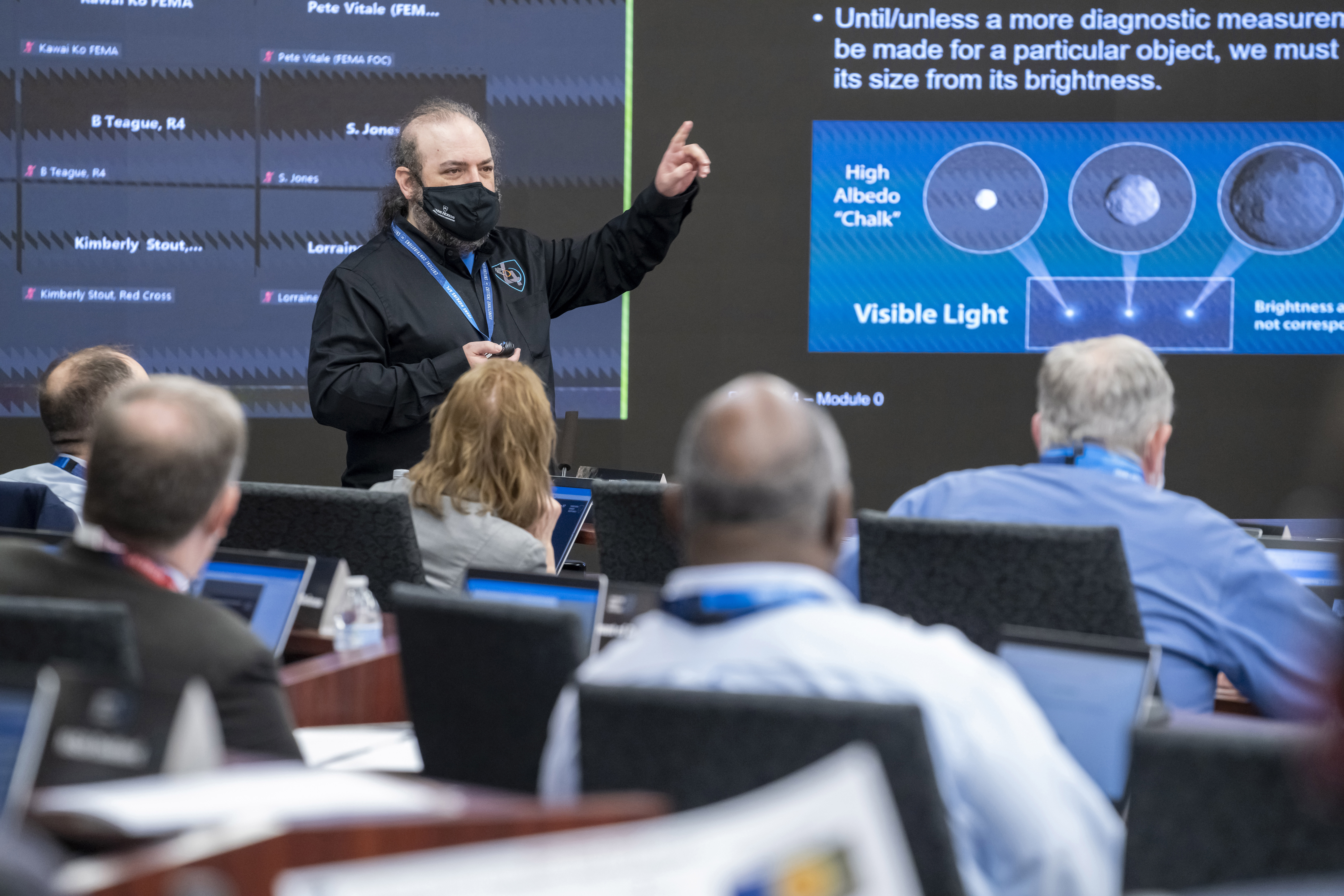Representatives from NASA, the Federal Emergency Management Agency, U.S. Space Command and other federal, state and local agencies convened recently at the Johns Hopkins Applied Physics Laboratory (APL) in Laurel, Maryland, for the fourth iteration of a Planetary Defense Interagency Tabletop Exercise to assess our nation’s ability to respond effectively to a (simulated) asteroid impact threat to Earth.

While there are no predicted asteroid impact threats to our planet for the foreseeable future, this exercise — sponsored by NASA and FEMA — focused extensively on the federal, state and local coordination that would be necessary to respond to an actual threat. Conducted in part to address activities called for in the National Near-Earth Object Preparedness Strategy and Action Plan, which outlines the nation’s strategy to address the hazard posed by near-Earth objects (NEOs), exercises of this nature are among many activities the government regularly conducts to ensure our nation’s preparedness for any natural disaster.
“While NASA has previously led and participated in simulated asteroid impact scenarios, this specific exercise marked the first time an end-to-end simulation of this type of disaster was studied, to include assessing a scenario from discovery of the asteroid impact threat through the aftermath effects of its hypothetical impact with Earth,” said Lindley Johnson, planetary defense officer at NASA Headquarters. “An asteroid impact to our planet is potentially the only natural disaster humanity is capable of accurately predicting and preventing. Conducting exercises of this nature enables government stakeholders to identify and resolve potential issues before real-world actions to respond to an actual asteroid impact threat would ever be needed.”
On Feb. 23-24, in the Laboratory’s high-tech Collaborative Analysis Center, government officials were guided through a detailed hypothetical scenario in which astronomers “discover” an asteroid likely to impact Earth in six months. As more information was revealed to participants through a series of modules, it became clear that the simulated asteroid would indeed hit near Winston-Salem, North Carolina. Specific details such as the asteroid’s size — and therefore its impact energy and the damage it would cause — remained highly uncertain until just days before the simulated impact.
The process mimicked how this information could actually unfold due to limitations of current capabilities, such as ground-based radar that requires an object to be relatively close to Earth to image and analyze. It also required close coordination across federal, state and local government levels to ensure all stakeholders knew how and where to access information as it became available.
“FEMA is an ‘all-hazards’ agency and responds to all domestic disasters and emergencies, so when it became evident this simulated asteroid would impact somewhere within the United States, it required this level of interagency coordination” said Leviticus “L.A.” Lewis, FEMA detailee to the Planetary Defense Coordination Office at NASA Headquarters. “This fourth interagency asteroid impact tabletop exercise provided a forum for federal and local government officials to work through what an impending asteroid impact threat to the United States would look like, with the real people that would be needed for such discussions given this type of impact scenario.”
The workshop exercise marked another important milestone for NASA’s efforts in planetary defense, which continue to ramp up. In September, NASA’s Double Asteroid Redirection Test (DART) will be the world’s first mission to demonstrate technology for defending Earth against potential asteroid impacts. DART, built and operated by APL for NASA’s Planetary Defense Coordination Office, is on its way to a well-known asteroid that is not a threat to Earth to squarely impact the moon of the asteroid to change its motion in space such that it can be accurately measured using ground-based telescopes.
DART is designed to validate asteroid deflection computer models and demonstrate kinetic impact deflection as one viable method of responding to a future asteroid threat. However, for a technology like DART to be viable, it is imperative that an impact threat be discovered many years to a decade in advance.
The after-action report for the exercise is in the works and expected to be released publicly later this year. The APL team is also outlining potential follow-up workshops to dig deeper into the technology and capability gaps identified in this exercise, as well as to explore other ways to strengthen multiagency responses to natural disasters.
“APL’s management and operations of NASA’s DART mission is just one contribution to the nation’s planetary defense efforts,” said Mike Ryschkewitsch, head of APL’s Space Exploration Sector. “The opportunity to host and guide critical activities like this planetary defense tabletop exercise allows us to apply our broad and growing expertise to benefit multiple agencies, address serious technical challenges and, perhaps one day, help to protect the world.”
For more information about NASA’s planetary defense efforts, visit http://www.nasa.gov/planetarydefense. For more information on the DART mission, visit http://dart.jhuapl.edu.
Related Topics
Science
For Media Inquiries
For all media inquiries, including permission to use images or video in our gallery, please contact:
Michael Buckley
All Media Resources

